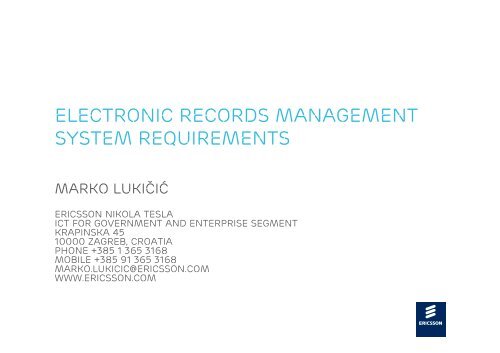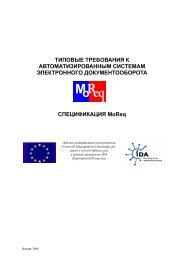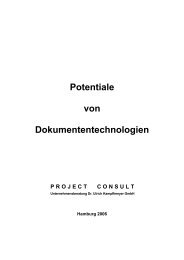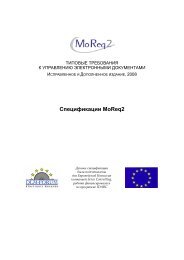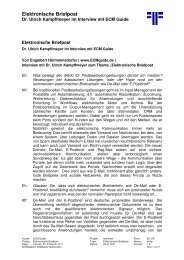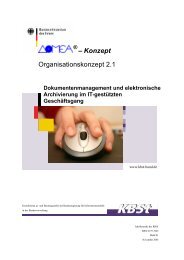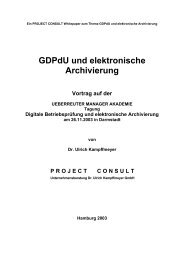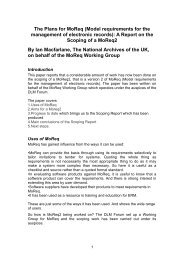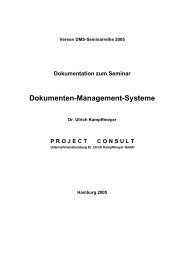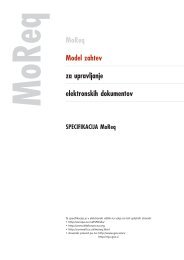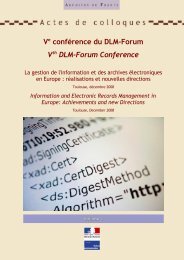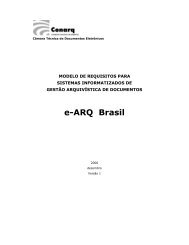Electronic Records Management System Requirements
Electronic Records Management System Requirements
Electronic Records Management System Requirements
You also want an ePaper? Increase the reach of your titles
YUMPU automatically turns print PDFs into web optimized ePapers that Google loves.
<strong>Electronic</strong> <strong>Records</strong> <strong>Management</strong><br />
<strong>System</strong> <strong>Requirements</strong><br />
Marko Lukičić<br />
Ericsson Nikola Tesla<br />
ICT for Government and Enterprise Segment<br />
Krapinska 45<br />
10000 Zagreb, Croatia<br />
Phone +385 1 365 3168<br />
Mobile +385 91 365 3168<br />
marko.lukicic@ericsson.com<br />
www.ericsson.com
Outline<br />
› ENTERPRISE RECORDS MANAGEMENT (ERM) SYSTEMS<br />
› ELECTRONIC AND NON-ELECTRONIC RECORDS<br />
› ERM KEY CHARACTERISTICS<br />
› STANDARDS FOR MANAGING ELECTRONIC RECORDS<br />
› MOREQ AND MOREQ2 SPECIFICATION<br />
© Ericsson Nikola Tesla 2009 INFuture2009, November 4-6, 2009, Zagreb, Croatia ERM <strong>System</strong> <strong>Requirements</strong>
Motivation<br />
› Key benefits of the electronic archives are well known<br />
– To eliminate costs of physical storage<br />
– To bypass the barriers of distributed offices<br />
– To form a backbone for electronic business<br />
› Automation of the whole process, from data acquisition to its<br />
classification, processing and archival<br />
› ERM systems<br />
– To assure that useless records are systematically destroyed while<br />
valuable information is protected and maintained<br />
› Content creation<br />
› Storing content<br />
› Content retrieval<br />
› Short and long-term preservation<br />
› Disposition<br />
© Ericsson Nikola Tesla 2009 INFuture2009, November 4-6, 2009, Zagreb, Croatia ERM <strong>System</strong> <strong>Requirements</strong>
What is a record?<br />
› ISO 15489-1:<br />
– „recorded information, in any format, that is created, received and<br />
maintains as evidence and information by an organization or person,<br />
in pursuance of legal obligations or in the transaction of business.“<br />
› opened for all types of records<br />
› an evidence of business action, transaction or any other activity<br />
- ex. contract, application, bill, etc.<br />
› To be authoritative, records must be:<br />
– Authentic<br />
– Reliable<br />
– Have integrity<br />
– Useable<br />
© Ericsson Nikola Tesla 2009 INFuture2009, November 4-6, 2009, Zagreb, Croatia ERM <strong>System</strong> <strong>Requirements</strong>
<strong>Records</strong> vs. Documents<br />
› Differences between documents and records<br />
Document<br />
A “piece” of information you can<br />
handle or manage<br />
May be important, or not<br />
Record<br />
A “piece” of information you can<br />
handle or manage<br />
Represents important evidence of<br />
decision or act<br />
Under the management of its “owner”<br />
(usually author)<br />
Under corporate management<br />
Can be changed at will<br />
Can be deleted at will<br />
Cannot be changed<br />
Cannot usually be deleted<br />
© Ericsson Nikola Tesla 2009 INFuture2009, November 4-6, 2009, Zagreb, Croatia ERM <strong>System</strong> <strong>Requirements</strong>
<strong>Records</strong> <strong>Management</strong><br />
› No general definition<br />
› ISO 15489-1<br />
– “the field of management responsible for the efficient and systematic<br />
control of the creation, receipt, maintenance, use and disposal of<br />
records, including processes for capturing and maintaining evidence<br />
of an information about business activities and transactions in the<br />
form of records.“<br />
› ERM should provide:<br />
– Reliability of records<br />
– Protected integrity<br />
– Compliance<br />
– Reflection of appropriate business activities<br />
– <strong>System</strong>atic creation, preservation and management of records<br />
© Ericsson Nikola Tesla 2009 INFuture2009, November 4-6, 2009, Zagreb, Croatia ERM <strong>System</strong> <strong>Requirements</strong>
<strong>Records</strong> <strong>Management</strong> standards<br />
DOMEA (Germany) . DOMEA concept is the most important guideline for the implementation<br />
of electronic records in Germany.<br />
It consists of three main sections: Organization concept, <strong>Requirements</strong> catalogue and<br />
Expansion modules.<br />
170.000 approved DOEMA licenses in Germany, Austria and Switzerland.<br />
ELAK (Austria). ELAK is a program for a simplification and consolidation of the federal<br />
internal management of records. In addition to DOMEA, the ELAK concept describes<br />
requirements and functions of the ERM systems in more technical detail.<br />
Gever (Switzerland). The Swiss Gever is collection of five standards that introduces<br />
management of electronic records and paper based records administration abandonment.<br />
The five standards are: Business Administration, Methods and functions with regard on legal<br />
defaults, Business model GEVER Federation, Service catalogue of GEVER applications and<br />
GEVER metadata.<br />
Protocollo Informatico/CNIPA (Italy). CNIPA (National Centre for Information Technologies<br />
in Public Administration) is the government organization responsible to give support to the<br />
Italian public administrations in creating information systems. Protocollo Informatico is<br />
document published by CNIPA that describes the electronic protocol as a framework of<br />
resources used by administrations for managing documents.<br />
© Ericsson Nikola Tesla 2009 INFuture2009, November 4-6, 2009, Zagreb, Croatia ERM <strong>System</strong> <strong>Requirements</strong>
<strong>Records</strong> <strong>Management</strong> standards<br />
ReMANO (Netherlands). ReMANO is a catalogue of software<br />
specifications for ERM systems in Duch government bodies. It is<br />
published in 2004. by “Nederlands Instituut voor Archiefonderwijs<br />
en – onderzoek”.<br />
NOARK (Norway). NOARK-4 is functional requirements<br />
specification for ERM and case management systems used in all<br />
public authorities in Norway.<br />
PRO/TNA (United Kingdom). The PRO/TNA document is<br />
developed by Public <strong>Records</strong> Office (The National Archive). Its<br />
main purpose is to provide a tool for benchmarking ability of<br />
government departments to support electronic records<br />
management.<br />
Replaced with MoReq2 specification.<br />
© Ericsson Nikola Tesla 2009 INFuture2009, November 4-6, 2009, Zagreb, Croatia ERM <strong>System</strong> <strong>Requirements</strong>
MoReq specification<br />
› The absence of the EU-wide standard<br />
– Complicates interoperable delivery of European eGovernment<br />
› DLM Forum<br />
– Constituted by European Commission<br />
– To investigate, promote and implement possibilities for wider<br />
cooperation in the field of electronic archives both between the<br />
Member States and at EU level<br />
– MoReq<br />
› Functional requirements<br />
- overview of ERM system functionalities, classification<br />
scheme, control and security, retention and disposal,<br />
capturing records, search, retrieval and rendering,<br />
administrative functionalities and other functionalities<br />
› Non-functional requirements<br />
- only in outline<br />
› ERM should be introduced to all offices and operational staff<br />
involved in creation, receiving and retrieving records<br />
› Used worldwide<br />
© Ericsson Nikola Tesla 2009 INFuture2009, November 4-6, 2009, Zagreb, Croatia ERM <strong>System</strong> <strong>Requirements</strong>
The MoReq2 project<br />
› MoReq problems<br />
– Guideline, not a standard<br />
› MoReq2<br />
› No conceivable proof of MoReq compliance<br />
› No advance since 2001<br />
› Technology has moved on<br />
› Uncontrolled MoReq translations referenced in<br />
particular ERM systems<br />
– Evolutionary update<br />
– Formally published at the beginning of 2008<br />
© Ericsson Nikola Tesla 2009 INFuture2009, November 4-6, 2009, Zagreb, Croatia ERM <strong>System</strong> <strong>Requirements</strong>
MoReq2 specification<br />
› A collection of obligatory and optional functional and non-functional<br />
requirements for the ERM systems<br />
› <strong>Requirements</strong> grouped in<br />
– The core module<br />
› Classification scheme and file organization, controls and security,<br />
retention and disposition, capturing and declaring records, referencing,<br />
searching, retrieval and presentation, and ERM system administration<br />
– Optional modules<br />
› <strong>Management</strong> of Physical (Non-electronic) Files and <strong>Records</strong>,<br />
Disposition of Physical <strong>Records</strong>, Document <strong>Management</strong> and<br />
Collaborative Working, Workflow, Casework, Integration with Content<br />
<strong>Management</strong> <strong>System</strong>s, <strong>Electronic</strong> Signatures, Encryption, Digital Rights<br />
<strong>Management</strong>, Distributed <strong>System</strong>s, Offline and Remote Working, Fax<br />
Integration and Security Categories.<br />
© Ericsson Nikola Tesla 2009 INFuture2009, November 4-6, 2009, Zagreb, Croatia ERM <strong>System</strong> <strong>Requirements</strong>
MoReq2 specification – The metadata model<br />
› Based on Dublin Core<br />
› Suggests minimum requirements<br />
– The starting point for customization and<br />
expansion<br />
› Sub-file<br />
– An intellectual subdivision of a file<br />
› Invoices, assessments, correspondences,<br />
…<br />
› Component<br />
– A bit stream that makes up a record or<br />
document<br />
› JPEG image of HTML document<br />
› Hybrid file<br />
– Omitted form the object model<br />
– MoReq2 allow classes, files, sub-files and<br />
volumes to contain electronic records and<br />
physical records together<br />
© Ericsson Nikola Tesla 2009 INFuture2009, November 4-6, 2009, Zagreb, Croatia ERM <strong>System</strong> <strong>Requirements</strong>
Conclusion<br />
› ERM systems assure that useless records are<br />
systematically destroyed while valuable information is<br />
protected and maintained<br />
› It is important to recognize the adequate ERM standard<br />
› MoReq2 – a step forward in unifying records management<br />
software standards and practices across Europe<br />
– Interoperability between ABC<br />
MOREQ2 WILL CONTRIBUTE TO THE ACHIEVEMENT<br />
OF THE GOALS OF THE EUROPE UNION’S I2010<br />
EGOVERNMENT ACTION PLAN.<br />
© Ericsson Nikola Tesla 2009 INFuture2009, November 4-6, 2009, Zagreb, Croatia ERM <strong>System</strong> <strong>Requirements</strong>


